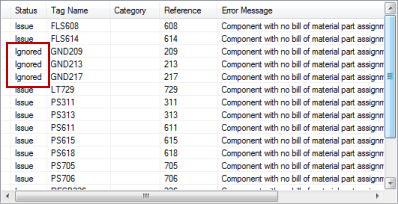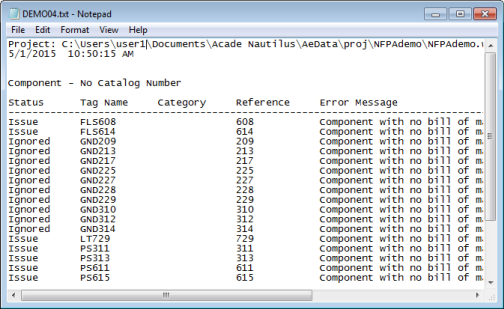Electrical Audit
Use this tool to identify and clean up some types of component and wire problems. The report includes the following types of problems:
- Wire ends not connected to anything
- Missing or duplicated wire numbers
- Duplicated components, terminals, pin values, cables, and cable wire colors
- Components with wire connection attributes but no wire connected
- Components without a catalog Value
- Child contacts not related to a parent
- Components in the same wire network from different categories. For example, a one-line symbol connected to a schematic symbol.
With this report you can:
- View the errors for the entire project or the active drawing only
- See the total number of errors
- View each tab that contains errors as indicated by

- Set the status of errors as either Ignored or Issue

- Hide all errors set as Ignored
- Surf to specific errors to view and correct
- Export the entire report or just one tab to a text file

- Print the errors on a single tab
There are a few things to keep in mind regarding errors marked as Ignored:
- If you export or print the results of the audit, ignored errors are included and are indicated in the Status column.
- The status of the errors is saved for each user not for the project. If another user runs the Electrical Audit on the same project, the status of each error defaults to Issue.
About the .wdn File
The .wdn file is a text file used by Electrical Audit specifically for auditing terminals. Terminal numbers listed in this file are not listed as duplicates. You can use wildcards to exclude a group of terminals for duplication checking. The following naming convention and search sequence is used:
- <project name>.WDN located in the same folder as the .wdp file for the active project
- DEFAULT.WDN located in the same folder as the .wdp file for the active project
- DEFAULT.WDN located in the default project folder, C:\Users\{username}\Documents\Acade {version}\AeData\Proj
The default .wdn file contains the terminal number filters GND*, PE, and E.
Real-Time Error Checking
The program checks for duplicated schematic component reference designations and wire numbers during the insert or edit process. You have the option of displaying the warning in real time. Real-time error checking is enabled by default in the Project Properties  Project Settings tab.
Project Settings tab.
If you enter an existing component tag/wire number during the insert/edit process, a warning dialog displays. The dialog alerts you of the duplication and suggests alternative tag names based on the user-defined format. You can select whether to use the duplicated tag or use a new tag that is suggested (or you can type in a new tag).
An error log file is created for every project regardless whether you chose to display the real-time warning dialog box or not. The log file is named <project_name>_error.logand is saved in the User folder.
Wire Error Checking
The Check/Repair Gap Pointers utility verifies that the invisible Xdata pointers on both sides of a wire gap/loop are valid. If not, appropriate pointers are established.
The Check/Trace a Wire utility troubleshoots problems with unconnected or shorted wires and invalid wire crossing gap pointers.

The Drawing Audit tool detects and fixes problems related to wires and wire numbers and displays a report. This tool can:
- Fix invalid wire crossing gap pointers
- Clean up invalid wire number and color/gauge label pointers
- Locate and erase zero length wires
- Locate and erase wire numbers not associated with a wire
- Show all valid wire segments by having each outlined in temporary graphics.